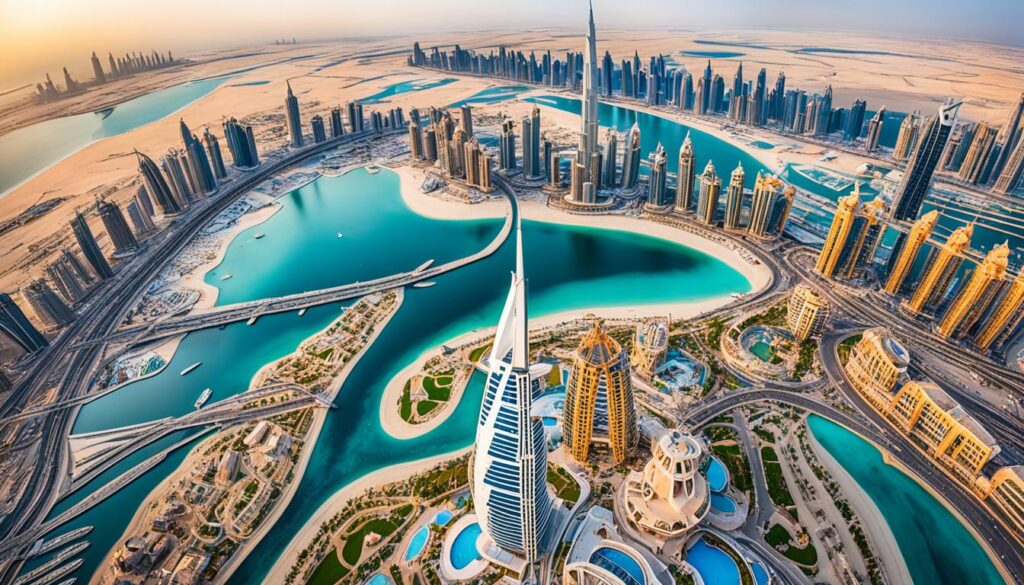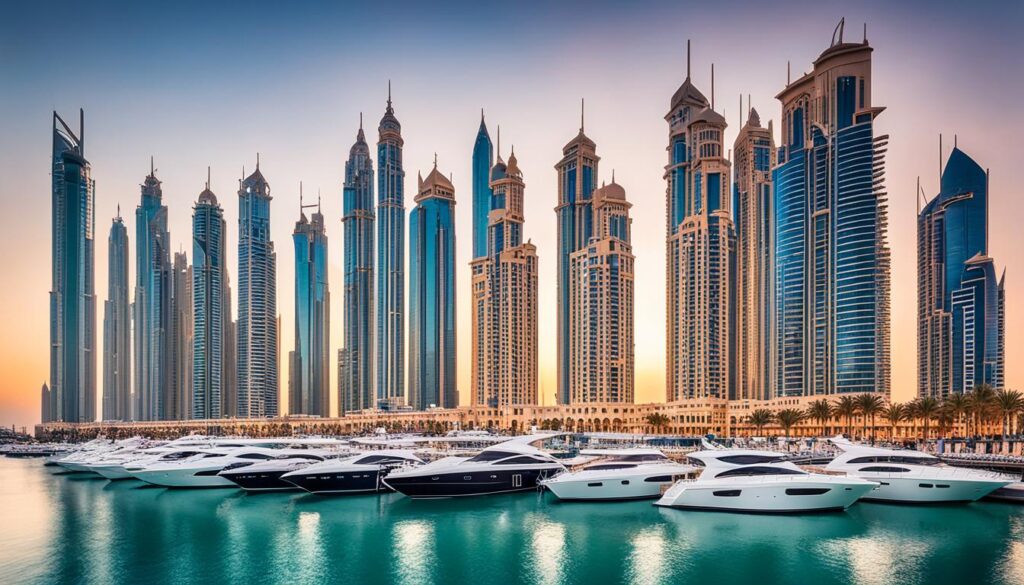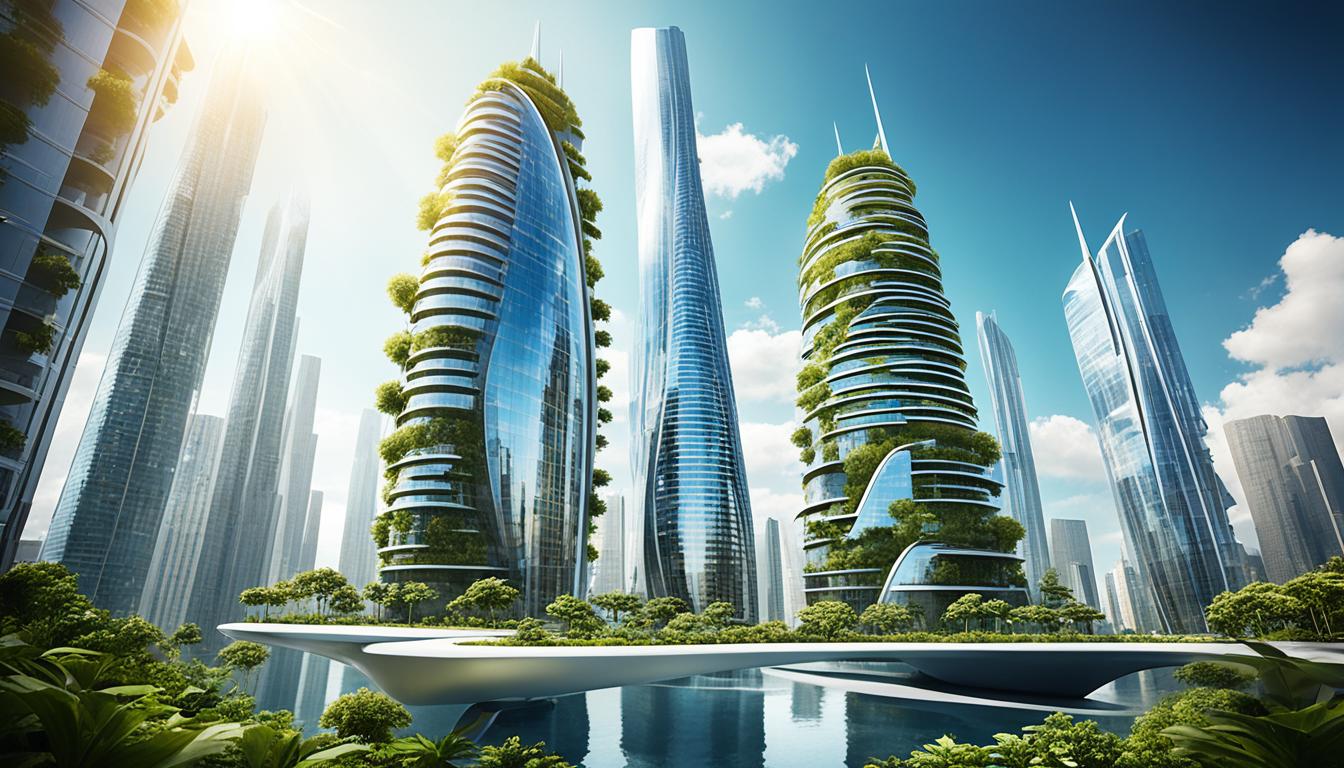Have you ever wondered what lies behind the architectural wonders that shape our cities? How does modern architecture push boundaries and captivate our imagination? Join us on a journey as we delve into the world of modern architecture and uncover the innovative and awe-inspiring contemporary buildings that redefine the urban landscape.
Key Takeaways:
- Modern architecture is transforming urban landscapes with its sustainable and innovative designs.
- Contemporary buildings push the boundaries of architectural design trends.
- Exploring modern architecture reveals a rich tapestry of styles and inspirations.
- Architectural wonders shape cities and leave a lasting impact on our cultural heritage.
- Uncovering the secrets behind modern architecture invites us to appreciate the artistry and ingenuity of these structures.
The Essence of Classical Architecture
Classical architecture is a timeless design style that traces its roots back to ancient civilizations, specifically drawing inspiration from Greek and Roman traditions. With its emphasis on symmetry and proportion, the use of columns and pediments, and intricate decorative details, classical architecture continues to captivate enthusiasts and inspire modern architectural design.
At the core of classical architecture is the belief that beauty and harmony can be achieved through mathematical precision. Symmetry and proportion are fundamental principles that govern classical buildings, creating a sense of balance and order in the overall design. Whether it’s a grand temple or a humble residence, classical architectural proportions create a pleasing visual experience for the observer.
Columns and pediments are notable features of classical architecture, serving both structural and aesthetic purposes. The use of columns, such as the iconic Doric, Ionic, and Corinthian orders, adds verticality and elegance to buildings. Pediments, triangular structures placed above entrances, showcase intricate sculptural details and provide a visual focal point.
Classical architecture also incorporates decorative elements to enhance the overall visual appeal. Elaborate moldings, cornices, and friezes adorned with intricate designs contribute to the richness and grandeur of classical buildings. These decorative details not only serve as artistic expressions but also highlight the craftsmanship and attention to detail that characterizes classical architecture.
Additionally, archways and porticos play a prominent role in classical architecture by providing dramatic entrances and organizing spaces. Arches create a sense of grandeur and serve as structural elements, enabling the construction of large spaces and supporting heavy loads. Porticos, covered entryways supported by columns, add depth and dimension to facades while offering shelter and creating a welcoming ambiance.
Classical architecture is a testament to the enduring beauty and elegance of its design principles. From the towering columns to the intricate decorative details, these buildings continue to inspire architectural styles to this day.
Frameworks Architects: Masters of Classical Design
Frameworks Architects is a renowned architectural firm specializing in classical design. With their expertise and attention to detail, they bring the timeless charm of classical architecture to various cities in North India. From Ludhiana to Amritsar, Jalandhar to Bathinda, Patiala to Delhi, Faridabad to Gurgaon/Gurugram, Noida to Ghaziabad, and Chandigarh to Mohali and Panchkula, Frameworks Architects showcases their mastery of classical design in every project they undertake.
The team at Frameworks Architects is dedicated to preserving the legacy and beauty of classical architecture. They understand the importance of symmetry, proportion, and intricate detailing that define classical buildings. Through their exceptional craftsmanship, they create architectural masterpieces that stand the test of time.
“Classical architecture is not just about replicating ancient styles; it’s about capturing the essence and principles that have influenced architecture for centuries. We take great pride in blending historical elegance with contemporary needs, creating designs that resonate with our clients and enrich the surrounding urban landscapes.”
Frameworks Architects’ portfolio showcases their versatility and expertise in classical design. From grand mansions to public buildings, their projects exude a sense of magnificence and sophistication. By seamlessly integrating classical elements such as columns, archways, and pediments, they create harmonious structures that captivate the eye and inspire awe.
Frameworks Architects believes that classical architecture has the power to create a lasting impact on communities. By infusing classical design principles into urban development, they contribute to the preservation of cultural heritage while also shaping the future of cities.
Whether it’s the restoration of a historic building or the creation of a new classical masterpiece, Frameworks Architects exemplifies the true essence of classical design. Their commitment to superior craftsmanship and attention to detail sets them apart as the masters of classical architecture.
Frameworks Architects’ Projects
Here are a few notable projects completed by Frameworks Architects:
| City | Project |
|---|---|
| Ludhiana | Beaux-Arts Mansion |
| Amritsar | Classical Courthouse |
| Chandigarh | Neoclassical Library |
| Delhi | Palladian Villa |
These projects reflect the firm’s ability to create architectural marvels that pay homage to classical design principles while meeting the functional needs of their clients.
https://www.youtube.com/watch?v=l3vWKPVIOvM
Combining expertise, innovation, and a deep appreciation for classical design, Frameworks Architects continues to leave an indelible mark in the world of architecture.
Embracing Classical Architecture in Urban Development
Frameworks Architects has successfully integrated classical architecture into the urban landscapes of Ludhiana, Chandigarh, and Delhi. With their expertise in classical design and meticulous attention to detail, they have revitalized these cities’ architectural splendor while maintaining a harmonious balance between tradition and modernity.
Ludhiana, located in the northern Indian state of Punjab, has witnessed a transformation in its urban development through the incorporation of classical architectural elements. The city’s skyline now boasts elegant facades, majestic columns, and intricate decorative details that pay homage to its rich cultural heritage.
Chandigarh, the capital city of Punjab and Haryana, is renowned for its urban planning and architectural significance. Frameworks Architects has played a key role in preserving the city’s architectural identity by seamlessly blending classical designs with contemporary structures. Classical archways, porticos, and ornate facades lend a timeless elegance to the cityscape, making it a haven for lovers of classical architecture.
Delhi, the capital of India, is known for its diverse architectural styles, with an abundance of historical monuments and modern structures. Frameworks Architects’ classical designs have brought a sense of grandeur to the city, harmonizing with iconic landmarks such as the India Gate and the Red Fort. The combination of classical and modern architecture creates a captivating visual narrative that showcases Delhi’s rich history and continuous urban development.
Through their commitment to classical architecture and urban development, Frameworks Architects has transformed Ludhiana, Chandigarh, and Delhi into cities that seamlessly blend tradition and modernity. These architectural marvels stand as testaments to the enduring appeal of classical design and the timeless beauty it brings to urban landscapes.
Discovering Dubai’s Architectural Wonders
Dubai, known for its mesmerizing modern architecture, is a city that never fails to awe visitors. With its breathtaking skyline and architectural marvels, Dubai showcases the perfect blend of innovation and luxury. From the world’s tallest building, the iconic Burj Khalifa, to the stunning Dubai Marina and the captivating Palm Jumeirah, this vibrant city offers a treasure trove of architectural wonders waiting to be explored.
Standing tall at a staggering height of 828 meters, the Burj Khalifa is an engineering marvel that dominates the cityscape. Its sleek design and breathtaking views from the observation deck make it a must-visit destination for architecture enthusiasts.
The Dubai Marina, a bustling waterfront district, is home to some of the most impressive skyscrapers in the world. The striking contemporary designs and innovative structures showcase the city’s commitment to pushing architectural boundaries.
“Dubai is like a dreamland for architects, constantly raising the bar in terms of modern architectural design. The city’s skyline is a testament to human ingenuity and creativity.”
Another architectural masterpiece in Dubai is the Palm Jumeirah, an artificial island shaped like a palm tree. This iconic development is home to luxurious residential buildings and hotels, redefining the concept of luxury living.

| Architectural Marvel | Description |
|---|---|
| Burj Khalifa | The tallest building in the world, offering breathtaking views of the city from its observation deck. |
| Dubai Marina | A vibrant waterfront district with stunning skyscrapers and contemporary designs. |
| Palm Jumeirah | An artificial island in the shape of a palm tree, featuring luxurious residential buildings and hotels. |
Dubai’s architectural wonders continue to amaze and inspire, attracting visitors from around the globe. Whether you are an architecture enthusiast or simply appreciate the beauty of modern design, exploring Dubai’s skyline is an experience like no other.
Embarking on a Guided Tour of Dubai’s Cityscape
A guided tour of Dubai is an excellent way for travelers to immerse themselves in the city’s vibrant neighborhoods and explore its breathtaking modern architecture. This curated experience allows visitors to witness the impressive cityscape and marvel at iconic landmarks that define Dubai’s skyline.
Discovering the Magnificent Burj Khalifa
One of the highlights of the guided tour is a visit to the Burj Khalifa, the tallest skyscraper in the world. Rising gracefully above the city, this architectural masterpiece offers panoramic views of Dubai’s stunning landscape. Step into the observation deck and witness the awe-inspiring cityscape sprawling below.
Exploring the Splendor of Dubai Marina

The tour also takes participants to the acclaimed Dubai Marina, a dazzling waterfront development renowned for its magnificent skyscrapers. Stroll along the Marina Walk and admire the sleek architectural designs that blend seamlessly with the sparkling waters. The modern skyscrapers create a unique cityscape that is a testament to Dubai’s innovative spirit.
Experiencing the Extravagance of Palm Jumeirah
No guided tour of Dubai is complete without a visit to Palm Jumeirah, the iconic man-made island shaped like a palm tree. This architectural marvel is home to luxurious resorts, upscale residences, and impressive entertainment options. Stroll along the palm-fringed crescent and witness the grandeur of the Palm Jumeirah up close.
By embarking on a guided tour of Dubai’s cityscape, visitors gain a deeper appreciation for the city’s modern architecture and its incredible transformation over the years. It is an immersive experience that allows travelers to witness the harmonious blend of modernity and innovation that defines Dubai’s architectural landscape.
Planning for Post-Tour Adventures in Dubai
After the guided tour of Dubai’s modern architecture, visitors have a range of transportation options available to continue their exploration. Dubai offers a well-connected public transportation system, taxis, car rental services, sightseeing buses, and additional guided tours. Whether you prefer the convenience of public transportation or the flexibility of renting a car, there are plenty of choices to suit your needs.
Public Transportation
Dubai’s public transportation system is an efficient and cost-effective way to get around the city. The Dubai Metro and the Dubai Tram connect major attractions and districts, making it easy to navigate. The Metro operates two lines, the Red Line and the Green Line, covering key areas such as Downtown Dubai, Dubai Marina, and the Palm Jumeirah. The Tram serves the Dubai Marina and Jumeirah Beach Residence areas, providing access to popular destinations along the coastline.
Taxis
Taxis are readily available in Dubai and provide a convenient option for transportation. Metered taxis are operated by the Dubai Taxi Corporation and are easily recognizable by their cream color. You can hail a taxi on the street, find them at designated taxi ranks, or book one through ride-hailing apps. Taxis offer a comfortable and reliable way to explore the city at your own pace.
Car Rental Services
If you prefer the freedom and flexibility of having your own vehicle, car rental services are widely available in Dubai. You can choose from a variety of rental companies and vehicle types to suit your preferences. Renting a car allows you to explore Dubai’s modern architecture at your own convenience and venture beyond the city limits to discover neighboring attractions.
Sightseeing Buses
If you’re looking for a hassle-free way to see the sights, hop-on-hop-off sightseeing buses are a popular choice. These buses offer comprehensive tours of Dubai’s major attractions, including its architectural marvels. With designated stops and informative commentary, sightseeing buses provide a convenient and educational experience for travelers.
Guided Tours
For those who want a deeper understanding of Dubai’s modern architecture, guided tours are an excellent option. Knowledgeable guides will take you on a curated journey through the city’s architectural highlights, providing insights and historical context. These tours offer a unique opportunity to learn about the design principles, construction techniques, and cultural significance of Dubai’s architectural wonders.
After exploring Dubai’s modern architecture, the transportation options available allow you to easily navigate the city and continue your adventure. Whether you choose to utilize the public transportation system, hail a taxi, rent a car, or join a sightseeing bus or guided tour, you’ll have the means to further immerse yourself in the architectural wonders of Dubai.
Conclusion
Exploring the marvels of modern architecture opens up a world of innovative and sustainable design. From classical elegance to futuristic skyscrapers, the architectural wonders of different cities provide a rich tapestry of styles and inspirations.
Architectural photography allows us to capture and appreciate the intricate details and grandeur of these remarkable structures. Through the lens, we can witness the harmonious blend of form, function, and creativity, showcasing the brilliance of modern architectural achievements.
Moreover, sustainable architecture is at the forefront of contemporary design, addressing the pressing need for environmentally friendly spaces. Architects around the world are embracing eco-friendly materials, energy-efficient systems, and sustainable practices to create buildings that minimize their carbon footprint and harmonize with nature.
As we continue to delve into the world of modern architecture, we are constantly enthralled by the boundless possibilities and innovations that push the boundaries of design. From the iconic landmarks that define city skylines to the hidden gems nestled in neighborhoods, the exploration of modern architecture promises an incredible journey of discovery and admiration.



